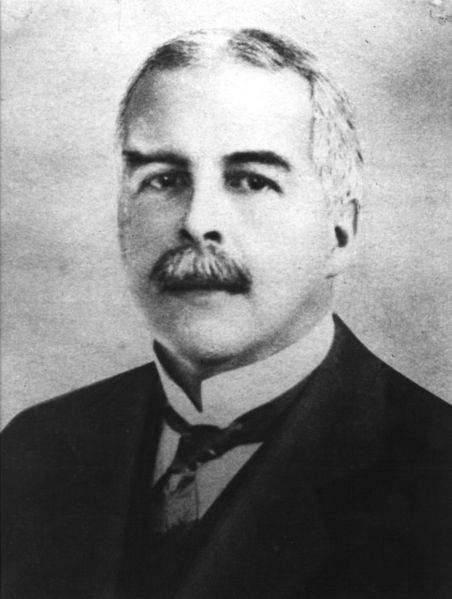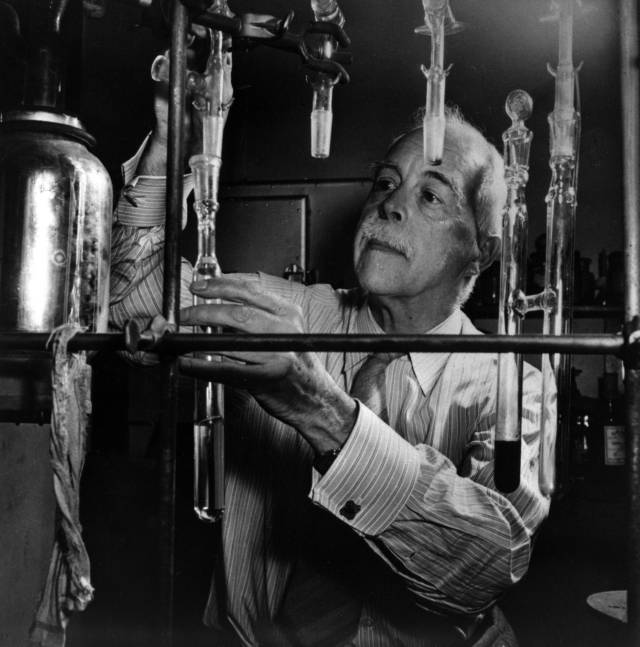<Back to Index>
- Chemist Gilbert Newton Lewis, 1875
- Painter Lawren Stewart Harris, 1885
- Swiss Federal Councillor Stefano Franscini, 1796
PAGE SPONSOR


Gilbert Newton Lewis (October 23, 1875 – March 23, 1946) was an American physical chemist known for the discovery of the covalent bond (Lewis dot structures and 1916 paper "The Atom and the Molecule"), his purification of heavy water, his reformulation of chemical thermodynamics in a mathematically rigorous manner accessible to ordinary chemists, his theory of Lewis acids and bases, and his photochemical experiments. In 1926, Lewis coined the term "photon" for the smallest unit of radiant energy. He was a brother in Alpha Chi Sigma, the professional chemistry fraternity, and for most of his long professorial career, a professor of chemistry at the University of California, Berkeley.
Lewis was born and raised in Weymouth, Massachusetts, where there exists a street named for him, G.N. Lewis Way, off of Summer Street. Additionally, the wing of the new Weymouth High School Chemistry department has been named in his honor. After earning his Ph.D. at Harvard under the direction of Theodore Richards, Lewis stayed as an instructor for a year before taking a traveling fellowship, studying under the physical chemists Wilhelm Ostwald at Leipzig and physicist Walther Nernst at Göttingen. While working in Nernst's lab, Nernst and Lewis apparently developed a lifelong enmity. A friend of Nernst's, Walther Palmaer, was a member of the Nobel Chemistry Committee. There is evidence that he used the Nobel nominating and reporting procedures to block a Nobel Prize for Lewis in thermodynamics by nominating Lewis for the prize three times, and then using his position as a committee member to write negative reports.
After
his stay in Nernst's lab, Lewis returned to Harvard as an instructor
for three more years, and in 1904 left to become Superintendent of
Weights and Measures for the Bureau of Science of the Philippine Islands in Manila. The next year he returned to Cambridge, Massachusetts, when the Massachusetts Institute of Technology (MIT)
appointed him to a faculty position, in which he had a chance to join a
group of outstanding physical chemists under the direction of Arthur Amos Noyes.
He became an assistant professor in 1907, associate professor on 1908,
and full professor in 1911. He left MIT in 1912 to become a professor
of physical chemistry and dean of the College of Chemistry at the University of California, Berkeley. Lewis Hall at Berkeley, built in 1948, is named in his honor. About 1902 Lewis started to use unpublished drawings of cubical atoms in his lecture notes, in which the corners of the cube represented possible electron positions.
Lewis later cited these notes in his classic 1916 paper on chemical
bonding, as being the first expression of his ideas. In 1908 he published the first of several papers on relativity, in which he derived the mass - energy relationship in a different way from Albert Einstein's derivation. In 1909, he and Richard Tolman combined his methods with special relativity. In 1912 Lewis and Edwin Bidwell Wilson presented a major work in mathematical physics that not only applied synthetic geometry to the study of spacetime, but also noted the identity of a spacetime squeeze mapping and a Lorentz transformation. Lewis also introduced the thermodynamic concept of activity and coined the term "fugacity". On June 21, 1912, he married Mary Hinckley Sheldon, daughter of a Harvard professor of Romance languages. They had two sons, both of whom became chemistry professors, and a daughter. In 1913, he was elected to the National Academy of Sciences.
He resigned in 1934, refusing to state the cause for his resignation;
it has been speculated that it was due to a dispute over the internal
politics of that institution or to the failure of those he had
nominated to be elected. His decision to resign may have been sparked
by resentment over the award of the 1934 Nobel Prize for chemistry to
his student, Harold Urey,
for the discovery of deuterium, a prize Lewis almost certainly felt he
should have shared for his work on purification and characterization of
heavy water. In 1916, he published his classic paper on chemical bonding "The Atom and the Molecule" in which he formulated the idea of what would become known as the covalent bond, consisting of a shared pair of electrons, and he defined the term odd molecule (the modern term is free radical) when an electron is not shared. He included what became known as Lewis dot structures as well as the cubical atom model. These ideas on chemical bonding were expanded upon by Irving Langmuir and became the inspiration for the studies on the nature of the chemical bond by Linus Pauling. In 1919, by studying the magnetic properties of solutions of oxygen in liquid nitrogen, he found that O4 molecules were formed. This was the first evidence for tetratomic oxygen. In 1921, Lewis was the first to propose an empirical equation describing the failure of strong electrolytes to obey the law of mass action, a problem that had perplexed physical chemists for twenty years. His empirical equations for what he called ionic strength were later confirmed to be in accord with the Debye - Hückel equation for strong electrolytes, published in 1923. In 1923, he formulated the electron - pair theory of acid - base reactions. In the so-called Lewis theory of acids and bases, a "Lewis acid" is an electron - pair acceptor and a "Lewis base" is an electron - pair donor. This year he also published a monograph on his theories of the chemical bond. Based on work by J. Willard Gibbs, it was known that chemical reactions proceeded to an equilibrium determined by the free energy of the substances taking part. Lewis spent 25 years determining free energies of various substances. In 1923 he and Merle Randall published the results of this study, which helped formalize modern chemical thermodynamics. In 1926, he coined the term "photon" for the smallest unit of radiant energy (light). Actually, the outcome of his letter to Nature was not what he had intended. In the letter, he proposed a photon being a structural element, not energy. He insisted on the need for a new variable, the number of photons. Although his theory differed from the quantum theory of light introduced by Albert Einstein in 1905, his name was adopted for what Einstein had called a light quantum (Lichtquant in German). Lewis was the first to produce a pure sample of deuterium oxide (heavy water) in 1933 and the first to study survival and growth of life forms in heavy water. By accelerating deuterons (deuterium nuclei) in Ernest O. Lawrence's cyclotron, he was able to study many of the properties of atomic nuclei. During the 1930s, he was mentor to Glenn T. Seaborg, who was retained for post-doctoral work as Lewis' personal research assistant. Seaborg went on to win the 1951 Nobel Prize in Chemistry and have the element Seaborgium named in his honor while he was still alive. Over
the course of his career, Lewis published on many other subjects
besides those mentioned above, ranging from the nature of light quanta to the economics of price stabilization. In the last years of his life, Lewis and graduate student Michael Kasha, his last research associate, established that phosphorescence of organic molecules involves an excited triplet state (a state in which electrons that would normally be paired with opposite spins are instead excited to have their spin vectors in the same direction) and measured the magnetic properties of this triplet state. In
1946, a graduate student found Lewis's lifeless body under a laboratory
workbench at Berkeley. Lewis had been working on an experiment with
liquid hydrogen cyanide, and deadly fumes from a broken line had leaked into the laboratory. The coroner ruled that the cause of death was coronary artery disease,
but some believe that it may have been a suicide. Berkeley Emeritus
Professor William Jolly, who reported the various views on Lewis's
death in his 1987 history of UC Berkeley’s College of Chemistry, From Retorts to Lasers, wrote that a higher-up in the department believed that Lewis had committed suicide. If Lewis's death was indeed a suicide, a possible explanation was depression brought on by a lunch with Irving Langmuir.
Langmuir and Lewis had a long rivalry, dating back to Langmuir's
extensions of Lewis's theory of the chemical bond. Langmuir had been
awarded the 1932 Nobel Prize in chemistry for his work on surface chemistry,
while Lewis had not received the Prize despite having been nominated 35
times. On the day of Lewis's death, Langmuir and Lewis had met for
lunch at Berkeley, a meeting that Michael Kasha recalled only years
later. Associates
reported that Lewis came back from lunch in a dark mood, played a
morose game of bridge with some colleagues, then went back to work in
his lab. An hour later, he was found dead. Langmuir's papers at the Library of Congress confirm that he had been on the Berkeley campus that day to receive an honorary degree.